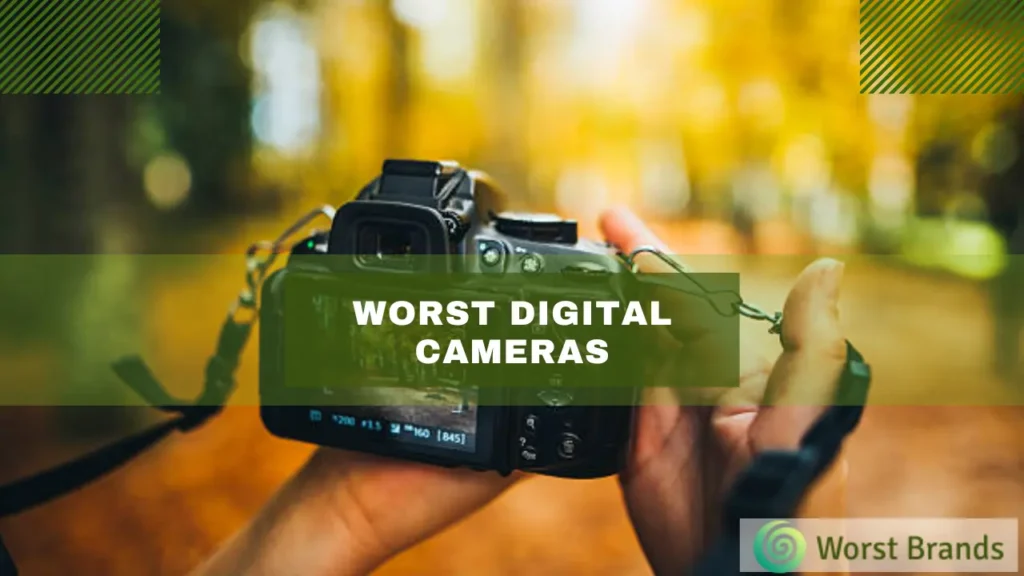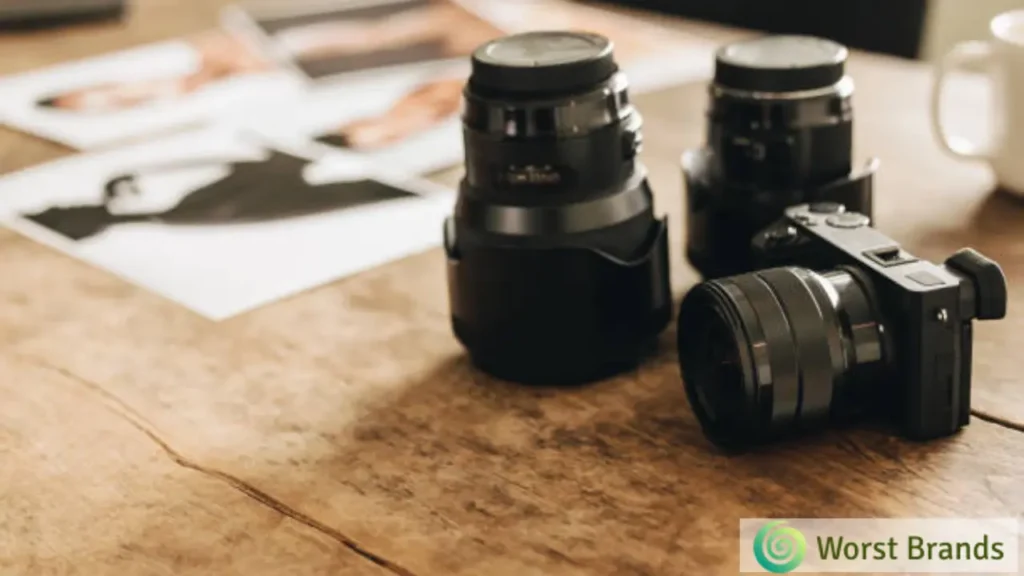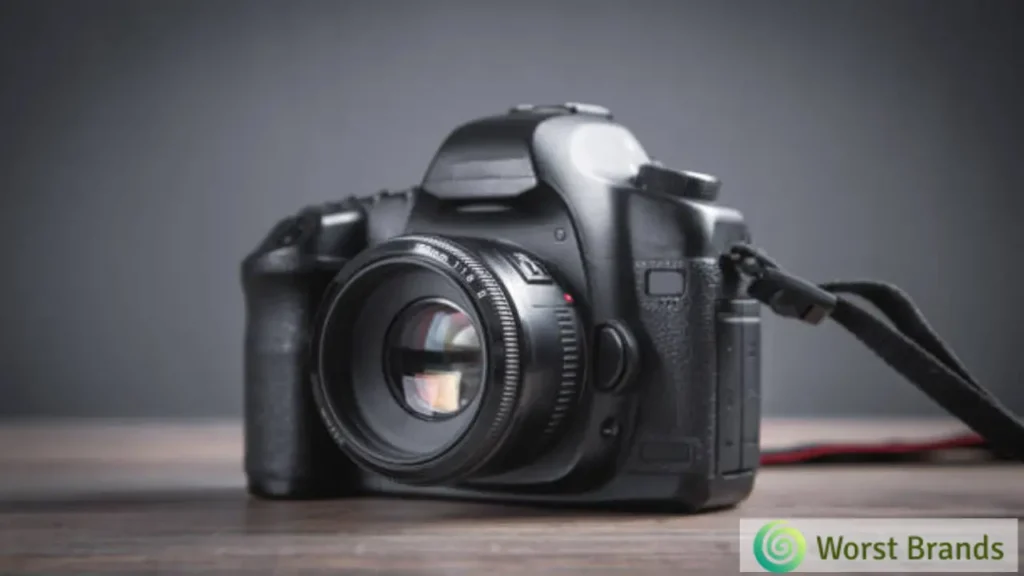In my journey as a travelling blogger, I’ve come across a wide array of cameras. While some have left me in awe, a few have unfortunately fallen short of expectations.
Drawing upon personal experiences and deep dives, I’ve listed the worst digital cameras that might not live up to their hype.
Before you invest in your next photographic companion, take a moment to explore these options that you might want to sidestep.
Table of Contents
10 Worst Digital Cameras
Due to slow autofocus, poor image quality, cumbersome usage, and software lags, the worst digital cameras to avoid are Pentax K-01, Lytro Illum 2, OMGLife Autographer, Ricoh GXR, Yashica Y35, and a few others.

Pentax K-01
Sporting a distinctive design, the Pentax K-01 stood out in the crowd.
Yet, while using it, the slow autofocus proved a major drawback, especially when capturing dynamic scenes or fleeting moments.
Its weight and bulk added to the woes, turning potential photography sessions into cumbersome affairs. The balance between style and functionality was skewed.
Lytro “Light Field” Camera
The Lytro’s promise was huge – capturing the entire light field. Yet, the excitement waned when I finally got my hands on it.
The images lacked the depth and detail you’d expect from such a groundbreaking technology.
It was an innovative concept but couldn’t deliver on its promises. Hence, it is among the digital cameras to avoid.
Lytro Illum 2
A follow-up to its predecessor, the Illum 2 promised to rectify shortcomings.
But, it, too, shared its predecessor’s primary flaw: subpar image quality like that of the worst home security camera.
Despite its unique refocusing features, photos often seemed to lack the sharpness and vibrancy you’d expect.
OMGLife Autographer

When I first saw the OMGLife Autographer, I was genuinely intrigued.
The idea of a life-logging tool that could effortlessly capture my day-to-day experiences seemed like a dream come true.
But in reality, this dream was far from realized. But its erratic shooting pattern meant many of those moments were missed or poorly captured.
Furthermore, its advertised “seamlessness” often felt more disturbing than intuitive. While its ambition was commendable, its execution left a lot to be desired.
If you’re in the market for reliable photography equipment, this one might be on the list of worst digital cameras.
From my experience, the Autographer’s promise was overshadowed by its glaring inconsistencies.
Ricoh GXR
Next up on the bad cameras list is Ricoh GXR. A modular camera system, the Ricoh GXR intrigued many with the promise of ultimate versatility.
However, the constant need to swap out modules for different scenes became a hassle in practice.
Instead of enhancing the photography experience, it felt like an added layer of work.
Yashica digiFilm Camera Y35
It was an ambitious attempt to combine the film’s vintage feel with modern digital convenience. While the concept was unique, the execution faltered.
But, its digital “film” cartridges felt more gimmicky than functional. Images often came out grainy and lacked the vibrancy of actual film.
Samsung Galaxy NX
The idea of merging Android OS with a DSLR caught my attention, and I was eager to test the Samsung Galaxy NX.
The promise of blending intuitive software with professional photography was compelling.
But as I started using it, software lags became a recurring issue. Though seemingly insignificant, these tiny delays often meant missing a perfect shot.
The battery life, too, was disappointing. For a technologically advanced and user-friendly camera, the Galaxy NX fell short in execution.

Polaroid Socialmatic
Envisioned as a bridge between photography and social media, the Socialmatic could’ve been a millennial’s dream.
However, its bulky design felt counterintuitive, and the substandard image quality didn’t do justice to moments worth sharing.
Leica M10-D
Given Leica’s esteemed reputation, I had high expectations when trying out the Leica M10-D. Still, it turned out to be a bad digital camera.
The absence of an LCD was intended to offer a more traditional photographic experience.
However, in my hands-on time with it, I found that this decision seemed a bit out of touch with modern photography needs.
While the craftsmanship was top-notch, not having instant feedback via an LCD made the shooting process less intuitive, especially considering its high-end market position.
Sigma SD1 / Merrill
The introduction of the Foveon sensor promised unparalleled color depth and detail.
However, in real-world testing, results from the Sigma SD1 were inconsistent at best.
Despite its potential, competitors often outpaced the camera’s performance at lower price points.
What Makes a Bad Camera? 7 Red Flags
In the vast world of photography, the camera is more than just a tool—it’s the key to unlocking your creative potential. But how do you discern a gem from a dud?
It’s a bit like figuring out which gaming controllers won’t ruin your gaming experience.
Here’s a practical look at factors that can downgrade a camera’s appeal.

Image Quality
Isn’t the whole point of a camera to capture stunning images?
- Sensor Snags: Sometimes, even in the most picturesque settings, a subpar sensor can leave your shots flat and lifeless.
- Resolution Restrictions: When you want to capture the fine details, an inadequate resolution can be your worst enemy.
Slow Autofocus
A momentary focus delay can cause missed opportunities, especially in dynamic settings.
Limited Manual Controls
As an expert photographer, I appreciate the importance of adjusting settings. Cameras without this flexibility can be restrictive.
Build Quality
A camera’s durability can be crucial, especially if you’re traveling or exposed to various elements.
Battery Life
Short-lived batteries can be inconvenient, especially during long shoots or while traveling.
Complicated User Interface
A straightforward and intuitive UI makes the photographer’s job much easier.
Lack of Expandability
Over time, you might want to add lenses or accessories. Cameras that don’t support this can feel limiting.
You might also love to read about the worst gimbal brands. worst quality drones, laptops to avoid, smartwatches to avoid, or earbuds to avoid.
Conclusion
While some cameras promise groundbreaking features, they might not always meet expectations.
It’s clear that even among renowned brands, some models fall into the category of worst digital cameras.
Making informed decisions is crucial as you venture forward in your photography pursuits.
Always prioritize your specific needs and do thorough research before settling on a choice.
After all, a camera is an investment, not just in money but in the memories you’ll capture. Choose wisely, and steer clear of those that might disappoint.
Christopher Evans is a Mechanical Engineer and is a distinguished expert in tire and electronic appliance testing with over 15 years of experience. Holding certifications like Automotive Tire Service (TIA) and Certified Appliance Professional (CAP). He is also a member of the the American Society of Mechanical Engineers (ASME) and has significantly contributed to safety standards and testing protocols in both industries. Evans is a respected speaker and award recipient.
